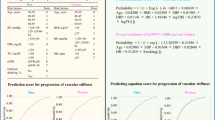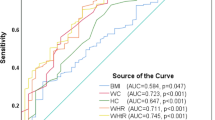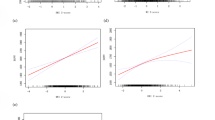Abstract
The aim of this study was to determine the effect of metabolic syndrome on brachial-ankle pulse wave velocity (baPWV) by using the new guidelines for diagnosis of this syndrome in Japan. We examined 525 men and women without a history of cardiovascular disease or cancer, and an ankle-brachial index<0.9. The baPWV was measured using a device (Form PWV/ABI) that simultaneously monitored bilateral brachial and ankle pressure wave forms. Metabolic syndrome was defined as a waist circumference ≥85 (90) cm in men (women) and two or more of the following risk factors: hypertension, dyslipidemia, and glucose intolerance diagnosed by a 75 g oral glucose tolerance test. The baPWV showed a significant linear relationship with waist circumference, waist-to-hip ratio, body fat, systolic and diastolic blood pressure, triglycerides, fasting glucose, 2-h-postload glucose, fasting insulin, and glycosylated hemoglobin-A1c, after adjusting for sex and age. These factors were also strongly related to fasting insulin levels. When subjects were classified into six groups based on waist circumference and the number of risk factors for metabolic syndrome (0, 1, and ≥2), we found that more risk factors clearly increased the odds ratios for an elevated baPWV in those subjects in the highest quartile of the baPWV distribution in multivariate logistic models. An increase in odds ratio was observed despite a normal waist circumference and may well have been due to increased fasting insulin and blood pressure levels. An increase in the number of risk factors for metabolic syndrome was highly correlated with an increased baPWV, probably due to insulin resistance.
Similar content being viewed by others
Article PDF
References
Oliver JJ, Webb DJ : Noninvasive assessment of arterial stiffness and risk of atherosclerotic events. Arterioscler Thromb Vasc Biol 2003; 23: 554–566.
O'Rourke MF, Staessen JA, Vlachopoulos C, Duprez D, Plante GE : Clinical applications of arterial stiffness; definitions and reference values. Am J Hypertens 2002; 15: 426–444.
Laurent S, Boutouyrie P, Asmar R, et al: Aortic stiffness is an independent predictor of all-cause and cardiovascular mortality in hypertensive patients. Hypertension 2001; 37: 1236–1241.
Sutton-Tyrrell K, Najjar SS, Boudreau RM, et al: Elevated aortic pulse wave velocity, a marker of arterial stiffness, predicts cardiovascular events in well-functioning older adults. Circulation 2005; 111: 3384–3390.
Meaume S, Benetos A, Henry OF, Rudnichi A, Safar ME : Aortic pulse wave velocity predicts cardiovascular mortality in subjects >70 years of age. Arterioscler Thromb Vasc Biol 2001; 21: 2046–2050.
Ishizaka N, Ishizaka Y, Toda E, Hashimoto H, Nagai R, Yamakado M : Hypertension is the most common component of metabolic syndrome and the greatest contributor to carotid arteriosclerosis in apparently healthy Japanese individuals. Hypertens Res 2005; 28: 27–34.
Tomiyama H, Yamashina A, Arai T, et al: Influences of age and gender on results of noninvasive brachial-ankle pulse wave velocity measurement—a survey of 12517 subjects. Atherosclerosis 2003; 166: 303–309.
Ohmori K, Emura S, Takashima T : Risk factors of atherosclerosis and aortic pulse wave velocity. Angiology 2000; 51: 53–60.
Yamashina A, Tomiyama H, Arai T, et al: Brachial-ankle pulse wave velocity as a marker of atherosclerotic vascular damage and cardiovascular risk. Hypertens Res 2003; 26: 615–622.
Ohnishi H, Saitoh S, Takagi S, et al: Pulse wave velocity as an indicator of atherosclerosis in impaired fasting glucose the Tanno and Sobetsu study. Diabetes Care 2003; 26: 437–440.
Nakamura U, Iwase M, Nohara S, Kanai H, Ichikawa K, Iida M : Usefulness of brachial-ankle pulse wave velocity measurement: correlation with abdominal aortic calcification. Hypertens Res 2003; 26: 163–167.
Reaven GM : Banting lecture 1988. Role of insulin resistance in human disease. Diabetes 1988; 37: 1595–1607.
Eckel RH, Grundy SM, Zimmet PZ : The metabolic syndrome. Lancet 2005; 365: 1415–1428.
Takeuchi H, Saitoh S, Takagi S, et al: Metabolic syndrome and cardiac disease in Japanese men: applicability of the concept of metabolic syndrome defined by the National Cholesterol Education Program–Adult Treatment Panel III to Japanese men: the Tanno and Sobetsu study. Hypertens Res 2005; 28: 203–208.
Third Report of the National Cholesterol Education Program (NCEP) Expert Panel on Detection, Evaluation, and Treatment of High Blood Cholesterol in Adults (Adult Treatment Panel III) final report. Circulation 2002; 106: 3143–3421.
Alberti KG, Zimmet PZ : Definition, diagnosis and classification of diabetes mellitus and its complications. Part 1: diagnosis and classification of diabetes mellitus provisional report of a WHO consultation. Diabet Med 1998; 15: 539–553.
‘Metabolic Syndrome’ Shindan-Kijun Kentou Iinkai (Expert Committee on the Diagnosis and Classification of Metabolic Syndrome) : ‘Metabolic Syndrome’ No Teigi To Shindan-Kijun (Guideline for diagnosis of metabolic syndrome). Nihon Naika Gakkai Zasshi 2005; 94: 794–809 ( in Japanese).
Nakanishi N, Suzuki K, Tatara K : Clustered features of the metabolic syndrome and the risk for increased aortic pulse wave velocity in middle-aged Japanese men. Angiology 2003; 54: 551–559.
Nakanishi N, Shiraishi T, Wada M : Brachial-ankle pulse wave velocity and metabolic syndrome in a Japanese population: the Minoh study. Hypertens Res 2005; 28: 125–131.
Nakamura M, Sato S, Shimamoto T : Improvement in Japanese clinical laboratory measurements of total cholesterol and HDL-cholesterol by the US Cholesterol Reference Method Laboratory Network. J Atheroscler Thromb 2003; 10: 145–153.
Expert Committee on the Diagnosis and Classification of Diabetes Mellitus : Report of the Expert Committee on the Diagnosis and Classification of Diabetes Mellitus. Diabetes Care 1997; 20: 1183–1197.
Prineas RJ, Crow RS, Blackburn H : The Minnesota Code Manual of Electrocardiographic Findings: Standards and Procedures for Measurement and Classification. Bristol, John Wright & Sons, 1982, 229 pp.
Yamashina A, Tomiyama H, Takeda K, et al: Validity, reproducibility, and clinical significance of noninvasive brachial-ankle pulse wave velocity measurement. Hypertens Res 2002; 25: 359–364.
The Examination Committee of Criteria for ‘Obesity Disease’ in Japan, Japan Society for the Study of Obesity: New criteria for ‘obesity disease’ in Japan. Circ J 2002; 66: 987–992.
Kitamura A, Iso H, Iida M, et al: Trends in the incidence of coronary heart disease and stroke and the prevalence of cardiovascular risk factors among Japanese men from 1963 to 1994. Am J Med 2002; 112: 104–119.
Matthews DR, Hosker JP, Rudenski AS, Naylor BA, Treacher DF, Turner RC : Homeostasis model assessment: insulin resistance and beta-cell function from fasting plasma glucose and insulin concentrations in man. Diabetologia 1985; 28: 412–419.
Hansen TW, Jeppesen J, Rasmussen S, Ibsen H, Torp-Pedersen C : Relation between insulin and aortic stiffness: a population-based study. J Hum Hypertens 2004; 18: 1–7.
Sengstock DM, Vaitkevicius PV, Supiano MA : Arterial stiffness is related to insulin resistance in nondiabetic hypertensive older adults. J Clin Endocrinol Metab 2005; 90: 2823–2827.
Ahluwalia N, Drouet L, Ruidavets JB, et al: Metabolic syndrome is associated with markers of subclinical atherosclerosis in a French population-based sample. Atherosclerosis ( available on-line 29 August 2005).
Okamura T, Moriyama Y, Kadowaki T, Kanda H, Ueshima H : Non-invasive measurement of brachial-ankle pulse wave velocity is associated with serum C-reactive protein but not with alpha-tocopherol in Japanese middle-aged male workers. Hypertens Res 2004; 27: 173–180.
Tomiyama H, Koji Y, Yambe M, et al: Elevated C-reactive protein augments increased arterial stiffness in subjects with the metabolic syndrome. Hypertension 2005; 45: 997–1003.
Sattar N, Williams K, Sniderman AD, D'Agostino R Jr, Haffner SM : Comparison of the associations of apolipoprotein B and non-high-density lipoprotein cholesterol with other cardiovascular risk factors in patients with the metabolic syndrome in the Insulin Resistance Atherosclerosis Study. Circulation 2004; 110: 2687–2693.
Ho RC, Davy K, Davy B, Melby CL : Whole-body insulin sensitivity, low-density lipoprotein (LDL) particle size, and oxidized LDL in overweight, nondiabetic men. Metabolism 2002; 51: 1478–1483.
Friedlander Y, Kidron M, Caslake M, Lamb T, McConnell M, Bar-On H : Low density lipoprotein particle size and risk factors of insulin resistance syndrome. Atherosclerosis 2000; 148: 141–149.
Saito I, Folsom AR, Aono H, Ozawa H, Ikebe T, Yamashita T : Comparison of fatal coronary heart disease occurrence based on population surveys in Japan and the USA. Int J Epidemiol 2000; 29: 837–844.
Author information
Authors and Affiliations
Corresponding author
Rights and permissions
About this article
Cite this article
Tsubakimoto, A., Saito, I., Mannami, T. et al. Impact of Metabolic Syndrome on Brachial-Ankle Pulse Wave Velocity in Japanese. Hypertens Res 29, 29–37 (2006). https://doi.org/10.1291/hypres.29.29
Received:
Accepted:
Issue date:
DOI: https://doi.org/10.1291/hypres.29.29
Keywords
This article is cited by
-
Impact of acute mental stress on segmental arterial stiffness
European Journal of Applied Physiology (2020)
-
HIV is an independent predictor of aortic stiffness
Journal of Cardiovascular Magnetic Resonance (2014)
-
Variation of serum monocyte chemoattractant protein-1 in patients with diabetes and metabolic syndrome
Journal of Huazhong University of Science and Technology [Medical Sciences] (2011)
-
The relation of metabolic syndrome according to five definitions to cardiovascular risk factors - a population-based study
BMC Public Health (2009)
-
Arterial stiffness in diabetes and the metabolic syndrome: a pathway to cardiovascular disease
Diabetologia (2008)



